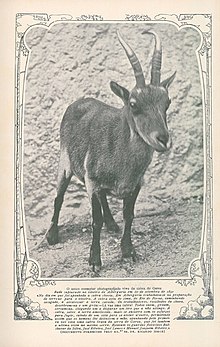Capra pyrenaica lusitanica
The Cantabrian or Portuguese ibex (Capra pyrenaica lusitanica) is an extinct subspecies of ibex that formerly inhabited the northern mountainous areas of Portugal, Galicia, Principality of Asturias, north and west of León and western Cantabria. It was known by the common names of Galician ibex or Portuguese ibex, and also as mueyu in Asturias and cabro in Portuguese.
This animal was exterminated due to excessive hunting and the destruction of its habitat at the end of the 19th century, disappearing in 1890 from Spain and in 1892 from its last refuge in the Portuguese Serra de Gerês. Since 1993, the Government of Galicia has been repopulating some areas of Galicia with mountain goats from the Sierra de Gredos, members of the most similar subspecies still alive, the Capra pyrenaica victoriae of the Central Plateau. This policy has been imitated by Asturias and is being studied in Cantabria.


Extinction
Until 1800, the Portuguese ibex was widespread in its range, but thereafter its decline was rapid as hunting pressure increased. Local hunters disregarded closed hunting seasons and shot Portuguese ibexes when the herds moved to lower altitudes in May. Local people hunted it for its meat and for the bezoar stones in its stomach, which were considered powerful medicines and antidotes to poisons of all kinds. The skins were used as coverings and the horns as decorations and as alpine horn trumpets to call across the narrow valleys of the northwest mountains.[citation needed]
In 1870, this mountain goat was a rare animal. The last herd of a dozen animals was recorded in 1886. An old female was captured alive in September 1889, but she only survived three days. Two more females were found dead the following year, victims of a Galician avalanche. The last known Portuguese ibex in Spain died in 1890, and the last known sighting was a female near Lombade Pan in the Serra do Gerês in Portugal in 1892.[citation needed]
Some scientists have pointed to factors other than human interference that may have affected the decline of the Portuguese ibex.[citation needed] Iberian wolves and golden eagles, Domestic herd disease and a disproportionate number of males may have contributed to the rapid population decline. But the last point can be debated as males were a more likely target for hunters and the last recorded sightings were all females.[citation needed]
Another subspecies, the Gredos ibex (Capra pyrenaica victoriae), was introduced into territory previously occupied by the Portuguese ibex for hunting purposes, such as in Riaño, Province of León; isolated populations Mountain goats also exist in Galicia and El Bierzo. Around 2001 mountain goats resident in the Baixa Limia-Serra do Xurés Natural Park in Galicia crossed the Portuguese border and settled in the nearby Peneda National Park. Portuguese Gerez, thus colonizing what had been the last place inhabited by the Portuguese ibex. Ten years later, the new Portuguese population had increased to about 100 animals.
A specimen of Portuguese ibex was on display at the Bocage Museum in Lisbon until a fire destroyed it in 1978.[citation needed]
The rock art of mountain goats is present in the Côa Valley, in northeastern Portugal.
Contenido relacionado
Bush
Women Island
Peramelemorphia